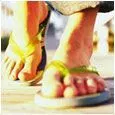

Prosthetics is the design, fabrication and fitting of custom-made artificial limbs or other types of assistive devices for patients who have lost limbs as a result of traumatic injuries, vascular diseases, diabetes, cancer or
congenital disorders. These devices will restore, as completely as possible, the function and appearance of a full or partial missing limb. With vast differences in human anatomy, the fabrication of prostheses is necessarily an
intricate, custom procedure requiring a high degree of skill and sophisticated technology. The preliminary, or temporary prosthesis is followed by a definitive prosthesis as soon as the residual limb is stable.
The design of the prosthesis is determined by the patient's physical changes, activity level, and functional needs. Amputees generally require a new device every few years for the remainder of their lives. Children, due to rapid
growth rates and high activity levels, along with extremely active adults need new prostheses on a more frequent basis. Prosthetic adjustments, repairs, realignment, and component upgrading are also aspects of ongoing treatment
Depending upon their complexity, prostheses represent a substantial investment of the health care dollar. Yet, studies have shown that, thanks to advanced designs and modern materials, those who require prosthesis are the most
fully and successfully rehabilitated of all segments of' the physically challenged population. Because of the improved function it allows, an appropriate prosthesis is an expenditure that more than pays for itself

